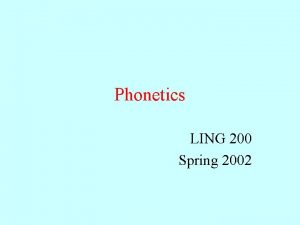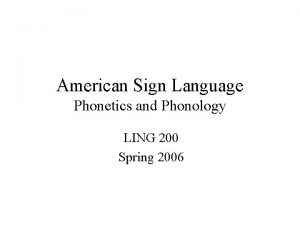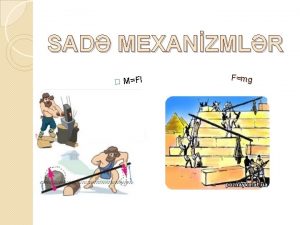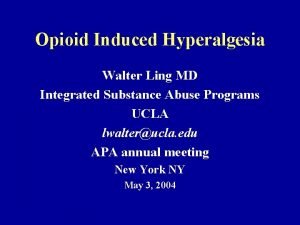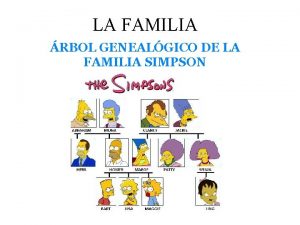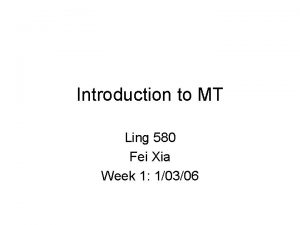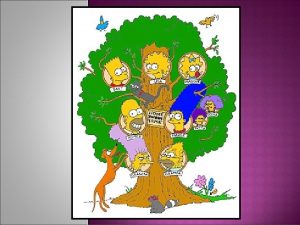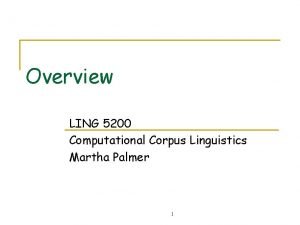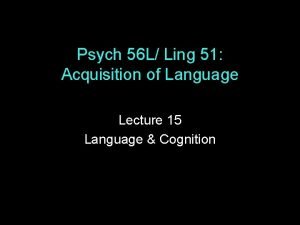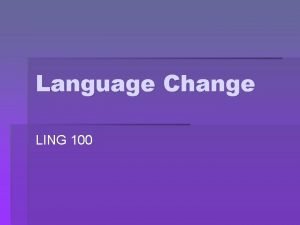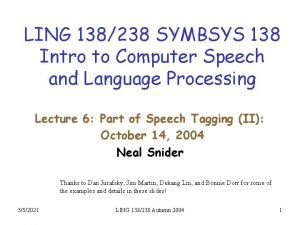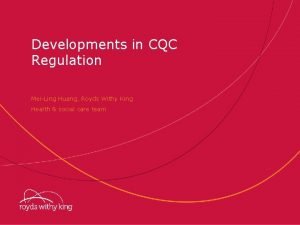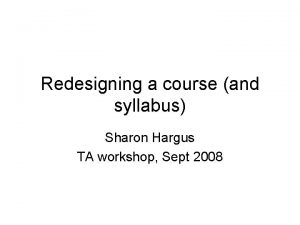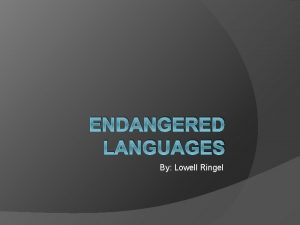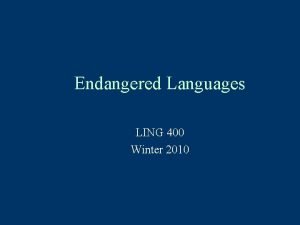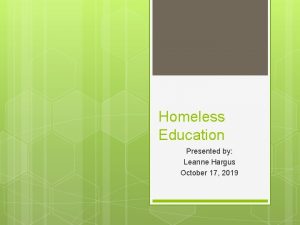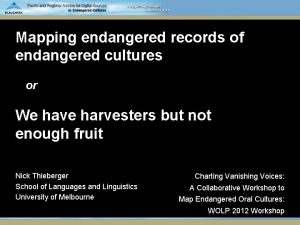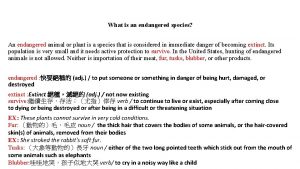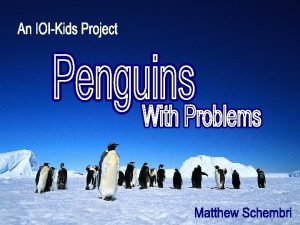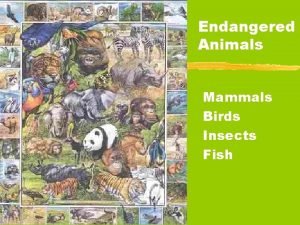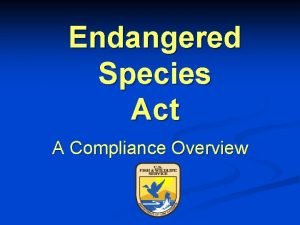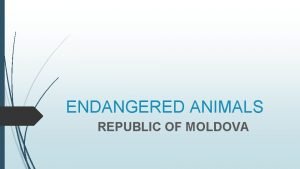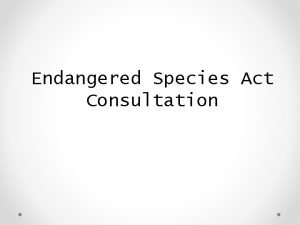Endangered Languages Prof Sharon Hargus LING 200 Spring












































- Slides: 44

Endangered Languages Prof. Sharon Hargus LING 200, Spring 2006

Overview Linguistic diversity Linguistic extinction Consequences of linguistic extinction The role of linguists

Linguistic Diversity

Estimating linguistic diversity 6912 languages n (Gordon 2005. http: //www. ethnologue. com) Spoken and signed languages Counting difficulties n n Dialect vs. language issue Poorly documented languages

Distribution of world’s languages area apx % of world’s lgs Europe 3 Americas 15 Africa 30 Australia and Pacific 19 Asia 32 Map on next slide


What creates linguistic diversity? Incremental changes to n n Grammar Lexicon English of Belfast, N. Ireland Divergence historically enhanced by isolation of speech communities

Another way of estimating linguistic diversity • Language families: tree model of divergence • E. g. , Celtic languages Proto-Celtic Continental Gaulish Irish Manx Insular Goidelic Scots Gaelic Brythonic Welsh Cornish Breton

Linguistic diversity in terms of language families • Language family estimates from Nichols 1990 • Geographic distribution of language families # remote families ØAmericas 122 -141 Australia and Pacific 47 Europe and N. Asia 14 -15 Africa 5 -14 188 -217 Map on next slide

Distribution of language families Each dot = 1 family of apx. 3000 -yr time-depth Europe Asia Americas Africa Australia

Pacific Northwest families Athabaskan, Salishan, Penutian, Numic, Chimakuan, Wakashan

Diversity summary Best measure of diversity is number of families, not languages n The languages within a family are all more similar to each other than they are to languages outside their family. Greatest areas of linguistic diversity n n Americas Australia, New Guinea

Linguistic Extinction

Linguistic extinction Diversification is normal Extinction is also normal Some extinct languages of Europe n n n Gaulish, Manx, Cornish (all Celtic) ‘Pictish’ (formerly spoken in Scotland) Etruscan (formerly spoken in Italy)

Irish Gaelic, a Celtic language • Yellow areas of map show places where native speakers of Irish Gaelic are most numerous within Ireland. • 1000 years ago all of Ireland would have been colored yellow. https: //depts. washington. edu/llc/olr/linguistics/clips/

Historical rates of linguistic survival Estimates from Nichols 1990 Typical historical scenario Ancestor Language Daughter 1 Daughter 2 Daughter 3 … 5 -6000 years later … 1. 6 languages < 1 Ancestor Lg Until recently, linguistic diversity has been increasing

Projections of linguistic diversity ‘Moribund’ languages ‘Endangered’ languages Krauss 1992 estimate: 50 -90% loss in coming century

Estimates of projected extinction < Summer Institute of Linguistics (www. ethnologue. com) 516 of the world’s languages are ‘nearly extinct’ n “only a few elderly speakers are still living” w Africa: 46 languages w Americas: 170 languages w Asia: 78 languages w Europe: 12 languages w Pacific: 210 languages

North America In 1996, 208 languages (Goddard 1996) n n 62 families and isolates 71% spoken by middle-aged and older 14% spoken by parents of young children 15% being learned by children as L 1 At first contact with Europeans, roughly 400 languages

Estimates of projected extinction < Krauss 1992 area % moribund languages Alaska and Siberia 90% US and Canada 80% Central America, Mexico 17% S. America 27% N. and S. America 33% Australia 90%

Makah (Wakashan family) Formerly spoken in Washington state 2002, 2 speakers 0 speakers

Navajo How quickly a language can become endangered n n 1970: 90% of children in boarding schools lacked preschool experience with English 1990 s. 2 independent estimates: w 50%+ Head Start children are monolingual English speakers w 50% of 5 -year-olds have no knowledge of Navajo; only about 16% are competent speakers

Why languages die Genocide of speakers n n War (e. g. Wounded Knee) Epidemics Speech community displacement (e. g. Trail of Tears)

Why languages die Differences in the power and prestige of social groups social group A (and their lg) n n social group B (and their lg) Incentives to learn language of dominant group No incentives to learn language of non-dominant group

Why languages die Bombardment of dominant language n n Media: TV, radio, newspaper Non-speakers living in community: grandchildren etc. Language suppression in education n n Language of primary education Language of higher education

Extinction summary Lgc extinction has been a fact of history Current rates of loss are unprecedented Languages can become endangered in one generation Diverse causes of endangerment

Consequences of linguistic extinction

Positive consequences of lg loss Unity in the workplace n “The only thing I asked was, ‘Let’s work together in a language we can all understand’. ” [Owner of Texas insurance company, re the firing of 3 Spanish speakers for chatting in Spanish during the workday. ] The Texas Workforce Commission sided with the owner, and denied the women unemployment benefits. (“Clash of Cultures Tears Texas City”, New York Times, 9 -30 -97)

Positive consequences of lg loss Savings to taxpayers n Canada: all federal services, documents must be provided in both French, English w Canadian customs form: 6 pages w U. S. customs form: 2 pages n U. S. : elections pamphlets in different languages ($$)

Positive consequences of lg loss Better socio-economic outlook n In 1995, ‘an Amarillo judge sparked a national controversy when he ordered a Mexican-American woman involved in a custody dispute to speak English to her 5 -year-old daughter. Otherwise, he said, “You’re abusing that child and you’re relegating her to the position of housemaid. ” (The judge later issued an apology to the woman and to “the profession of housekeeping. ”)

Negative consequences Scientific n Theories about language based on w 6700 languages, 200 families vs. w 200 languages, 20 families vs. w 12 languages, 5 families

Negative consequences Cultural n Language as a symbol of culture w Salt Lake City 2002 Olympic opening ceremony: Indian nations of Utah (Shoshoni, N. Paiute, S. Paiute, Navajo) made welcoming presentations in their own languages (not translated into English) n Sample attitudes about language and culture w Pascua Yaqui Tribal Council language policy: "Our ancient language is the foundation of our cultural and spiritual heritage. . . " w Damon Clarke (Hualapai): "For many of us, our language is the key. The key in thinking, our educational system, and our ways. " w Rosa Gonzalez (Spanish): “This is what I am. ”

Negative consequences Loss of local knowledge Biological n Geographical n Dictionary as cultural repository n

The role of linguists

Linguists and endangered languages What are linguists doing? What should linguists be doing? What shouldn’t linguists be doing? 3 points of view n n n Krauss Ladefoged Dorian

Krauss’s point of view Linguists need to support endangered lgs n n n Organized documentation effort Devote time to creation of pedagogical materials Advocate for languages The field of linguistics needs to support linguists involved in documentation n n Rethink grad school requirements Rethink criteria for promotion and tenure

Ladefoged’s point of view Linguists should document lgs with ‘professional detachment’ Linguists shouldn’t meddle in politics Linguists shouldn’t try to persuade speakers to have certain viewpoints about language n Speakers may view monolingualism in lg of dominant group as essential

Dorian’s point of view Documentation of minority languages is inherently political Linguists’ intervention probably of no consequence for lg survival anyway Language loss is catastrophic n n for descendants of speakers for linguistics Thorough lg documentation takes a toll on linguists Ladefoged-style documentation of the phonetics doesn’t require as much fieldwork time as other types of language documentation

Language and politics in N. Ireland https: //depts. washington. edu/llc/olr/linguistics/clips/ (Gaelic. Politics)

Draft United Nations declaration on the rights of indigenous peoples n (adopted 1994) Part III, Article 14 w Indigenous peoples have the right to revitalize, use, develop and transmit to future generations their histories, languages, oral traditions, philosophies, writing systems and literatures, and to designate and retain their own names for communities, places and persons. n Part IV, Article 15 w Indigenous children have the right to all levels and forms of education of the State. All indigenous peoples also have the right to establish and control their educational systems and institutions providing education in their own languages, in a manner appropriate to their cultural methods of teaching and learning.

United States 1990 Native American Languages Act SEC. 102. The Congress finds that-(1) the status of the cultures and languages of native Americans is unique and the United States has the responsibility to act together with Native Americans to ensure the survival of these unique cultures and languages; … SEC. 104. It is the policy of the United States to-(1) preserve, protect, and promote the rights and freedom of Native Americans to use, practice, and develop Native American languages; …

Ireland Official Languages Act 2003 n n http: //www. coimisineir. ie/ “The official languages” means the Irish language (being the national language and the first official language) and the English language (being a second official language)… w 8. ---(1) A person may use either of the official languages in, or in any pleading in or document issuing from, any court. …

More opinions from linguists Summer Institute of Linguistics n Endangered Languages page w http: //www. sil. org/sociolx/ndg-lg-home. html w Links to other resources n The Linguasphere Observatory w http: //www. linguasphere. org/language. html

Summary Often, minority languages endangered moribund extinct n n 25% language extinction in 5000 -6000 years is normal Extinction of 90% languages in 100 years is unprecedented Negative consequences of extinction are both scientific and cultural The role that linguists should play has been debated
 300+200+200+200
300+200+200+200 Ling 200
Ling 200 Characteristics of sign language
Characteristics of sign language Bae yong-kyun
Bae yong-kyun Winter summer spring autumn
Winter summer spring autumn 200 + 200 + 300
200 + 200 + 300 200+200+100+100
200+200+100+100 100 200 300
100 200 300 600+800+800
600+800+800 200 + 200 + 300
200 + 200 + 300 100 + 100 = 200
100 + 100 = 200 Ling
Ling Ling oa
Ling oa Ling shih fu
Ling shih fu Ling internet
Ling internet Tərpənməz blok
Tərpənməz blok Heart
Heart Walter ling
Walter ling Tio de bart simpson
Tio de bart simpson Tree in lung real photo
Tree in lung real photo Wang ling relationship
Wang ling relationship Mtling
Mtling Ling simpson
Ling simpson Agnes ling
Agnes ling Ling
Ling Language
Language Ling
Ling Dr ng li ling
Dr ng li ling Long term goals examples for freshers
Long term goals examples for freshers Huo lingyu
Huo lingyu Lam wai ling
Lam wai ling Graph4ai
Graph4ai Ling oa
Ling oa Ling 100
Ling 100 Erin ling
Erin ling Cheung yin ling
Cheung yin ling Ling138
Ling138 Nien-ling wacker
Nien-ling wacker Mei-ling huang
Mei-ling huang Jin ling cigarettes
Jin ling cigarettes Ling rolled
Ling rolled Archibald mclaren contribution in physical education
Archibald mclaren contribution in physical education Mei-ling from singapore was preparing
Mei-ling from singapore was preparing Ida ling
Ida ling Magic lam
Magic lam

